The Power Inverter Market is estimated to be valued at USD 88.5 billion in 2025 and is projected to reach USD 151.3 billion by 2035, registering a compound annual growth rate (CAGR) of 5.5% over the forecast period.
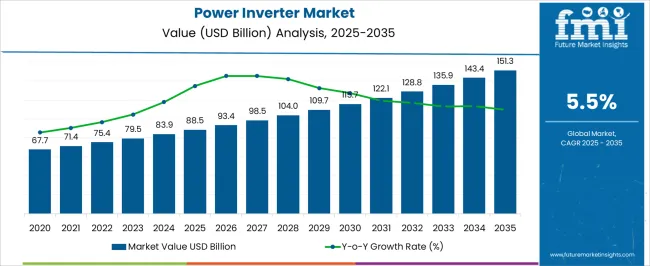
| Metric | Value |
|---|---|
| Power Inverter Market Estimated Value in (2025 E) | USD 88.5 billion |
| Power Inverter Market Forecast Value in (2035 F) | USD 151.3 billion |
| Forecast CAGR (2025 to 2035) | 5.5% |
The Power Inverter market is experiencing significant growth, driven by the increasing global adoption of renewable energy systems, energy storage solutions, and electrification initiatives across industrial, commercial, and utility sectors. Rising investments in solar photovoltaic (PV) installations and the growing emphasis on decentralized power generation are creating substantial demand for efficient and reliable inverters. Advancements in inverter technology, including enhanced efficiency, real-time monitoring, and grid compatibility, are enabling higher energy conversion and operational flexibility.
Growing awareness of energy efficiency and sustainability, combined with regulatory incentives and subsidies for renewable energy adoption, is further propelling market expansion. Inverters play a critical role in integrating renewable sources with electrical grids, ensuring stable power delivery and reducing energy losses.
The need for scalable, reliable, and cost-effective power conversion solutions is particularly pronounced in emerging markets, where electrification and renewable energy penetration are increasing rapidly Continuous technological innovation and rising demand for smart grid integration are expected to sustain long-term growth in the Power Inverter market.
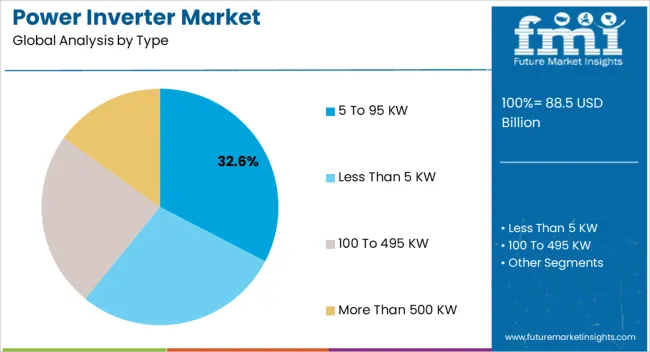
The 5 to 95 KW type segment is projected to hold 32.6% of the market revenue in 2025, establishing it as the leading type. Growth in this segment is driven by its suitability for a wide range of applications, including small- and medium-scale commercial, industrial, and residential solar PV systems. The versatility of these inverters allows for seamless integration with both off-grid and grid-tied energy systems, offering high efficiency and reliability.
Advanced features, such as real-time monitoring, over-voltage protection, and adaptive load management, enhance performance and minimize operational downtime. The ability to deliver scalable power output while maintaining energy quality and system stability has strengthened its adoption across various end-use sectors.
Increasing demand for energy-efficient solutions, government incentives for renewable energy adoption, and the proliferation of distributed energy resources are further supporting growth The combination of operational flexibility, performance reliability, and ease of integration ensures that the 5 to 95 KW type remains the preferred choice among manufacturers and end users in the evolving energy landscape.
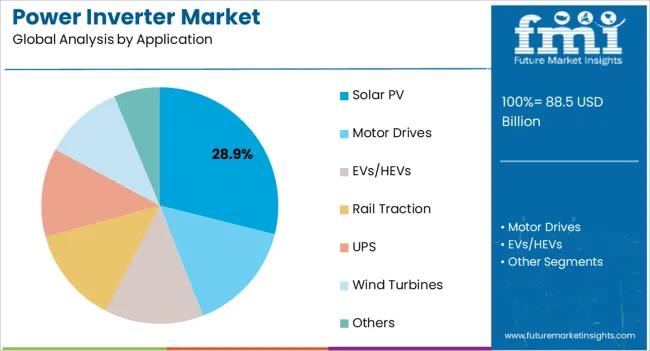
The solar PV application segment is expected to account for 28.9% of the market revenue in 2025, making it the leading application area. Growth in this segment is being driven by the rapid adoption of solar energy systems for residential, commercial, and utility-scale installations worldwide. Power inverters play a crucial role in converting direct current from solar panels into alternating current suitable for consumption and grid integration, ensuring high efficiency and minimal energy losses.
Technological advancements in inverter efficiency, smart monitoring, and compatibility with hybrid energy systems are enhancing adoption. Government incentives, renewable energy policies, and declining solar panel costs are further accelerating deployment. The increasing focus on energy independence, sustainability, and environmental regulations is compelling organizations and homeowners to integrate reliable inverter solutions with solar PV installations.
The solar PV segment’s dominance is reinforced by its role in enabling cost-effective, scalable, and environmentally friendly energy solutions As solar adoption continues to rise globally, the segment is expected to remain a key driver of Power Inverter market growth.
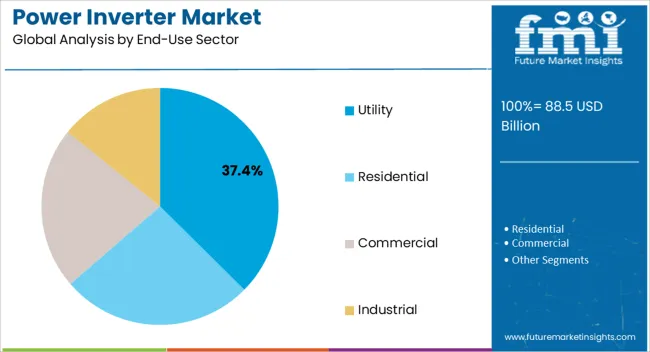
The utility end-use sector is projected to hold 37.4% of the market revenue in 2025, positioning it as the leading sector. Growth in this segment is being driven by large-scale renewable energy projects, grid modernization initiatives, and increasing demand for reliable power delivery. Power inverters in utility applications facilitate integration of solar, wind, and hybrid energy sources into the electrical grid while maintaining stability and efficiency.
Advanced inverters with grid support functionalities, real-time monitoring, and fault detection are being increasingly deployed to meet regulatory requirements and enhance system reliability. The ongoing global transition toward renewable energy and decarbonization is further boosting demand for high-capacity and scalable inverter solutions in utility-scale projects.
Investments in smart grid infrastructure, energy storage systems, and large solar PV farms are reinforcing adoption As utilities continue to focus on efficiency, reliability, and sustainability, this end-use sector is expected to remain the primary contributor to the Power Inverter market, supported by innovation in technology and increasing renewable capacity.
Rapid urbanization is a significant reason why the demand for power inverters is expected to increase. Rapid urbanization may lead to a rapid increase in the demand for electricity as well for the seamless performance of industries, factories, and other facilities.
Moreover, leading to an insufficient supply of electricity in certain areas, power cuts are often seen in such places. To ensure uninterrupted power supply, power inverters are installed in these areas. This is expected to increase the sales of power inverters.
Additionally, the increased consumption of electronic gadgets like television, laptops, air conditioners, etc., is also expected to surge the adoption of power inverters. Governments across the world are taking proactive steps to provide uninterrupted electricity in rural areas. For example, Deen Dayal Upadhyaya Gram Jyoti Yojana is one such initiative that has been started by the Indian government to provide electricity in rural areas across India.
Likewise, many nations have their initiatives. The increase in such initiatives is expected to boom the market size. An increase in disposable incomes has ultimately resulted in the power inverters being affordable to a rise in people. This is expected to increase the sales of power inverters.
| Category | By Type |
|---|---|
| Top Segment | 5 KW to 95 KW |
| Market Share in Percentage | 34.4% |
| Category | By Application |
|---|---|
| Top Segment | Motor Drive |
| Market Share in Percentage | 20.4% |
Moreover, the power inverters are noise-free, unlike power generators, which create a lot of noise while operating. There are also rapid developments shaping up in the field of electrical and electronics-based technology, because of which the power inverters might further evolve to improved versions. This as well is expected to increase the adoption of power inverters.
However, the high production cost of the power inverter remains a key cause of concern for the market. Moreover, the lower lifespan of the battery also poses a challenge to the market because, in such a case, the customers need to shell out their money for changing the battery, and this might lead to a huge amount being spent during the entire life cycle of the product.
| Regional Market Comparison | Global Market Share in Percentage |
|---|---|
| North America | 26.5% |
| Europe | 23.4% |
North America, which currently has a market share of 35.3%, is expected to be one of the largest markets for power inverters during the forecast period. The rapid growth of several industries, like IT, IoT, Healthcare, etc., in the region is expected to surge the adoption of power inverters in North America.
Moreover, people in this region spend most on time-consuming content from various electronic gadgets. This as well is a key driving force for the market in North America.
| Regional Market Comparison | Global Market Share in Percentage |
|---|---|
| United States | 18.4% |
| Germany | 10.4% |
| Japan | 5.3% |
| Australia | 2.4% |
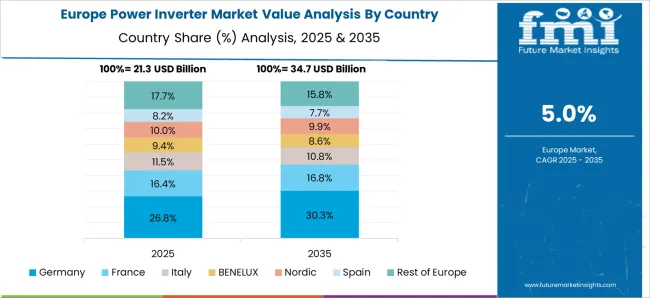
Europe, which currently has a market share of 24.1%, is expected to be one of the most significant markets for power inverters during the forecast period.
Apart from the growth of various industries, people in this region are generally looking for ways to reduce noise pollution. The power inverters help them achieve that, as they operate without making any noise.
| Regional Markets | CAGR (2025 to 2035) |
|---|---|
| United Kingdom | 3.2% |
| China | 4.3% |
| India | 8.5% |
With rapid urbanization and almost every sector requiring uninterrupted electricity for their smooth operation, the start-up community of the market is looking for ways to deliver continuous power supply. Some of the start-ups are Oxy Neuron, BREK Electronics, and SenMuLeiShi.
These start-ups are working towards creating innovative devices that help store electricity and reduce carbon footprint at astronomical levels. This technology is expected to offer a plethora of benefits to rural areas.
The start-ups are also working on power inverters, which can be used as EV charging stations as well. The start-ups have also developed silicon carbide-based composite architecture for solar inverters, which improves thermal conductivity and power in packages compared to conventional silicon-based inverters.

Some key players in the market are Omron Automation PVT Ltd, TMEIC, Tabuchi Electric Co., LTD., SMA Solar Technology, Schneider Electric SE, ABB Ltd., Samlex America Inc., Enphase Energy Inc., Thor Manufactures, and PowerBright.
With the increase in the demand for electricity, the leading players are mainly focusing on increasing production capacity. By doing so, these firms may be able to serve the growth of the renewable sector and also further strengthen their operations.
| Report Attributes | Details |
|---|---|
| Growth Rate | CAGR of 5.5% from 2025 to 2035 |
| Base Year for Estimation | 2025 |
| Historical Data | 2020 to 2025 |
| Forecast Period | 2025 to 2035 |
| Quantitative Units | Revenue in USD million and CAGR from 2025 to 2035 |
| Report Coverage | Revenue Forecast, Volume Forecast, Company Ranking, Competitive Landscape, Growth Factors, Trends, and Pricing Analysis |
| Segments Covered | Type, Application, End Use, Region |
| Regions Covered | North America; Latin America; Europe; East Asia; South Asia; Oceania; The Middle East and Africa |
| Key Countries Profiled | United States, Canada, Brazil, Argentina, Germany, United Kingdom, France, Spain, Italy, Australia & New Zealand, China, India, ASEAN, GCC, South Africa |
| Key Companies Profiled | Omron Automation PVT Ltd; TMEIC; Tabuchi Electric Co., LTD.; SMA Solar Technology; Schneider Electric SE; ABB Ltd.; Samlex America Inc.; Enphase Energy Inc.; Thor Manufactures; PowerBright. |
| Customization & Pricing | Available Upon Request |
The global power inverter market is estimated to be valued at USD 88.5 billion in 2025.
The market size for the power inverter market is projected to reach USD 151.3 billion by 2035.
The power inverter market is expected to grow at a 5.5% CAGR between 2025 and 2035.
The key product types in power inverter market are 5 to 95 kw, less than 5 kw, 100 to 495 kw and more than 500 kw.
In terms of application, solar pv segment to command 28.9% share in the power inverter market in 2025.






Full Research Suite comprises of:
Market outlook & trends analysis
Interviews & case studies
Strategic recommendations
Vendor profiles & capabilities analysis
5-year forecasts
8 regions and 60+ country-level data splits
Market segment data splits
12 months of continuous data updates
DELIVERED AS:
PDF EXCEL ONLINE
Ambulance Power Inverter Market Growth - Trends & Forecast 2024 to 2034
Automotive on board AC-DC power inverters Market Size and Share Forecast Outlook 2025 to 2035
Power Grid Fault Prediction Service Market Size and Share Forecast Outlook 2025 to 2035
Power Plant Boiler Market Forecast Outlook 2025 to 2035
Power Ring Rolling Machine Market Size and Share Forecast Outlook 2025 to 2035
Power Supply Equipment for Data Center Market Size and Share Forecast Outlook 2025 to 2035
Power Electronics Market Size and Share Forecast Outlook 2025 to 2035
Power Quality Equipment Market Size and Share Forecast Outlook 2025 to 2035
Power Generator for Military Market Size and Share Forecast Outlook 2025 to 2035
Power Tools Market Size and Share Forecast Outlook 2025 to 2035
Power Supply Isolation Equipment Market Size and Share Forecast Outlook 2025 to 2035
Power Window Lift Motor Market Size and Share Forecast Outlook 2025 to 2035
Powered Surgical Staplers Market Size and Share Forecast Outlook 2025 to 2035
Power Distribution Component Market Size and Share Forecast Outlook 2025 to 2035
Power Over Ethernet (PoE) Controllers Market Size and Share Forecast Outlook 2025 to 2035
Power Sports Market Size and Share Forecast Outlook 2025 to 2035
Power Conditioner Market Size and Share Forecast Outlook 2025 to 2035
Power Control Commercial Surge Protection Devices Market Size and Share Forecast Outlook 2025 to 2035
Power Transmission Component Market Size and Share Forecast Outlook 2025 to 2035
Power Optimizer Market Size and Share Forecast Outlook 2025 to 2035

Thank you!
You will receive an email from our Business Development Manager. Please be sure to check your SPAM/JUNK folder too.
Chat With
MaRIA